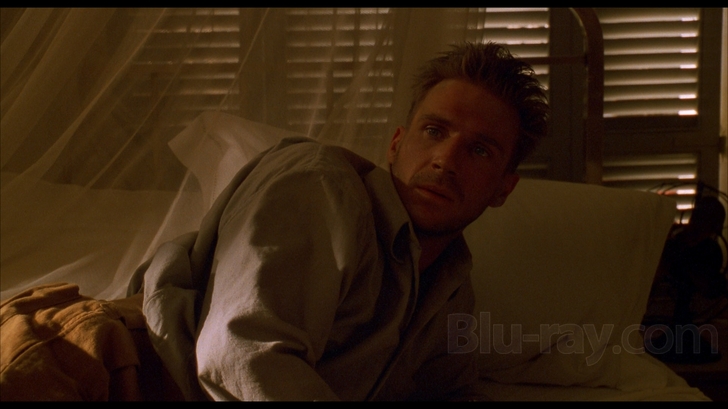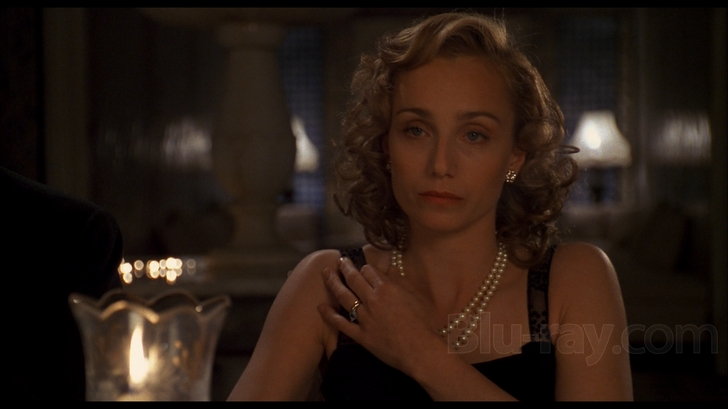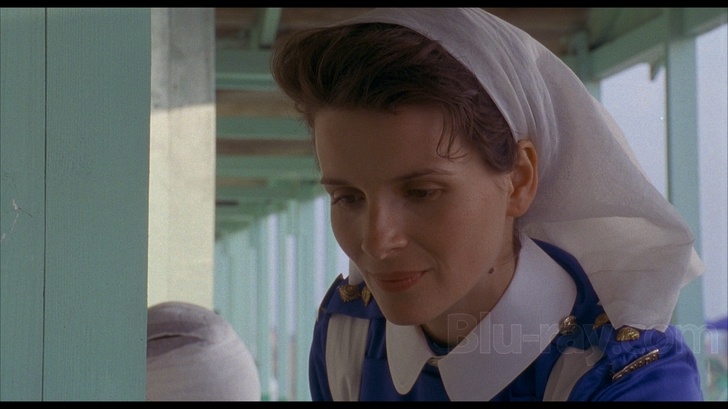The English Patient Blu-ray Movie
HomeThe English Patient Blu-ray Movie 
Lionsgate Films | 1996 | 162 min | Rated R | Jan 31, 2012
Movie rating
7.1 | / 10 |
Blu-ray rating
| Users | 4.6 | |
| Reviewer | 4.0 | |
| Overall | 4.4 |
Overview
The English Patient (1996)
At the close of WWII, a young nurse tends to a badly-burned plane crash victim. His past is shown in flashbacks, revealing a tragic love affair.
Starring: Ralph Fiennes, Juliette Binoche, Willem Dafoe, Kristin Scott Thomas, Naveen AndrewsDirector: Anthony Minghella
| Drama | Uncertain |
| Period | Uncertain |
| Romance | Uncertain |
| War | Uncertain |
| Melodrama | Uncertain |
| Epic | Uncertain |
Specifications
Video
Video codec: MPEG-4 AVC
Video resolution: 1080p
Aspect ratio: 1.85:1
Original aspect ratio: 1.85:1
Audio
English: DTS-HD Master Audio 5.1 (48kHz, 24-bit)
Subtitles
English, English SDH, Spanish
Discs
50GB Blu-ray Disc
Single disc (1 BD)
Playback
Region A (locked)
Review
Rating summary
| Movie | 4.5 | |
| Video | 4.0 | |
| Audio | 5.0 | |
| Extras | 3.5 | |
| Overall | 4.0 |
The English Patient Blu-ray Movie Review
Unadaptable? Hardly.
Reviewed by Jeffrey Kauffman January 23, 2012There’s a famous Seinfeld episode where Elaine, the snarky, boorish, politically incorrect character portrayed
with such relish by Julia Louis-Dreyfuss, finds herself increasingly at odds with seemingly everyone around her when
she professes her dislike—well, let’s be honest, her outright hatred—of the film The English Patient.
Elaine’s seething disregard for the titular character’s horrible fate in life, culminating in her angry catcall of “hurry up and
die already” might strike some (as it does most in the episode) as the height of an unfeeling lack of empathy. For those
who have slogged through one historical epic too many, it probably hits closer to its intended home of hilarity. Anthony
Minghella both wrote and directed the film version of The English Patient, adapting the well regarded novel by
Michael Ondaatje, and as I mentioned in my review of Minghella’s film version of Cold Mountain, he brought a
certain David Lean-esque approach to the novel’s gargantuan historical sweep and intimate character study. There’s
one salient difference between Minghella’s The English Patient and at least three of Lean’s best known
historical epics, namely Lawrence of Arabia, Doctor Zhivago, Ryan’s Daughter and A Passage to India.
Lean
had the ability to frame huge, indeed epochal, historic events in very personal terms. In Lawrence of Arabia, it
was of course a biographical piece on T.E. Lawrence, but it also was intimately wrapped up with the nascent ideas of
nationalism of various Arab peoples which would go on to define major sociopolitical movements of the later twentieth
century. Doctor Zhivago and Ryan’s Daughter may have been “mere” love stories at their core, but they
played out against (or indeed within) earth shattering events like the Bolshevik Revolution and the long simmering
“troubles” between Ireland and England. Only A Passage to India might seem to be at least somewhat outside
the bounds of this “history – personal story” dialectic, though it of course has the subtext of British colonialism and
class structure at its core. For that very reason, it might be considered the closest cousin to Minghella’s The English
Patient, for while Minghella’s film has several huge historical events playing out in the background, including World
War II, the film is much more about its characters than any great movements they find themselves reacting to. While of
course none of the main characters in the film can be completely divorced from their setting, the fact that supposedly
well known (and some frankly not so well known) historical events are somewhat tangential to the film’s storyline might
lead curmudgeons like Seinfeld’s Elaine to be repeatedly checking their collective watches, wondering when that
damned patient will in fact finally hurry up and die.

Before moving on to a perhaps less whimsical analysis of The English Patient, forgive me if I beg your forbearance for my own “Elaine” reaction with regard to this film. There’s no doubt that Minghella approaches his source material with all due reverence, and he weaves a very potent story out of simultaneously developing timeframes (something which may in fact confuse some first time viewers), and that may lead some into thinking, like Elaine, that The English Patient is nothing but pretentious hooey. The film is deadly serious most of the time, which brings me to one completely outré moment which stuck out to me so forcefully the first time I saw the film that it has never left my memory, nor my ability to totally separate its absurdity from the rest of the film’s rather somber tone. At around 1:44:39 into the film, the main female character, Katharine Clifton (Kristin Scott Thomas), who is embroiled in an extramarital affair with Hungarian Count Lazló de Almásy (who later becomes known as, yes, “the English patient”), breaks off the affair and walks out on the Count. Whereupon she smacks her head rather forcefully on the support to some bleachers she’s walking by. Kristin Scott Thomas’ head literally whiplashes back from the impact of this moment, and the first time I saw it, I just burst out laughing. Is there some deep psychological subtext to this moment that Minghella wanted us to grasp? The scene is obviously meant to be there, because there's a quick reaction shot of Ralph Fiennes' Count character, but it is such a patently odd moment, it raises questions more than anything. (To be fair, Minghella does address this weird moment in one of the commentaries on this Blu-ray disc, explaining there was a similar moment in Ondaatje's source novel, and that he wanted a scene of Clifton banging her head in the film. At least we know it was on purpose, if not exactly why it's there.)
The English Patient has a deliberately convoluted structure which might be likened to Russian nesting dolls. The main framing device finds a horribly burned patient being attended to by a concerned nurse named Hana (Juliette Binoche) as World War II winds down. Hana and this mysterious patient, who is assumed to be British, are housed in a labyrinthine Italian monastery. Hana is curious to find out more about her charge, but he is reticent, as well as physically incapable of sharing much information, but the film then begins to indulge in a series of flashbacks which slowly uncover the patient’s past as a celebrated Hungarian geographer who becomes entangled in a tempestuous affair which has disastrous results. Meanwhile another disfigured man arrives at the monastery, a Canadian intelligence officer named Caravaggio (Willem Dafoe) who is on the hunt for the man he blames for his infirmity. It doesn’t take a rocket scientist to figure out that Caravaggio’s story is ultimately going to intersect with the Hungarian Count’s.
Ondaatje’s source novel would seem to be one of the most unadaptable works of modern fiction, and it’s to Minghella’s immense credit that he has fashioned such an excellently flowing film, one which peels back a number of layers on each of the main characters. The Count, Katharine, Hana and Caravaggio are all wounded—physically in some cases, emotionally in all—and under Minghella’s rather inspired writing, we get snippets of their stories which help to slowly fill in the blanks. It’s perhaps ironic that one of the co-stars, Naveen Andrews, who plays a love interest of Juliette Binoche’s, would experience something quite similar in a television outing with Lost. The performances here all top notch, including Oscar winner Binoche, but also including very nice turns from a huge supporting cast that also features such notables as Colin Firth (as Thomas' jilted husband).
The film is huge and sumptuously beautiful a lot of the time (though the sight of the burn makeup might disturb easily upset viewers), and is in fact what is probably most redolent of the works of David Lean. Minghella shepherds his forces seemingly effortlessly here, delivering an emotionally satisfying experience that only the most churlish—like Seinfeld’s Elaine—would ever find objectionable.
The English Patient Blu-ray Movie, Video Quality 

The English Patient is presented on Blu-ray courtesy of Lionsgate-Miramax with an AVC encoded 1080p transfer in 1.85:1. This is a largely trouble free presentation, with an overall great looking print, though I would rate the results to be just slightly less formidable than others in this recent wave of Miramax catalog releases, more in tune with the image quality I described in Minghella's other big epic out this week, Cold Mountain. The differences between what I would term the first tier and the second tier levels of image quality are quite slight, but noticeable. As with Cold Mountain, The English Patient shows significantly more grain than releases like Frida or Shakespeare in Love. In fact, The English Patient probably shows the most grain of any of these four releases, grain which spikes rather dramatically in many of the desert scenes (look at the sky in some of the desert screencaps included in this review for some good examples). The image is very sharp otherwise, with well modulated colors and some really gorgeous reproductions of the amber lit hues with infuse a lot of the film. Some of the darker elements do suffer from very minor crush and, again as with Cold Mountain, there some negligible ringing in a few scenes.
The English Patient Blu-ray Movie, Audio Quality 

The English Patient's gloriously detailed sound design is presented via a beautifully rendered DTS-HD Master Audio 5.1 track that kicks into excellent immersion before the credits sequence even gets under way. The gentle tinkle of chimes and the thud of footsteps are cleanly presented, with the footsteps clearly in the left channel, and then we're off on a whirlwind journey that offers everything from awesome explosive LFE to gentler dialogue sequences. There are a number of hugely disparate segues in terms of the sound design here. The rattle of gunfire might immediately wash into the clink of glasses a peddler carries strung from bars on his shoulders, and the DTS track offers all of this with sterling fidelity and really impressive dynamic range. The film is full of fantastic panning effects and an above average use of discrete channelization even in dialogue sequences. The English Patient may not in fact be the stuff of summer blockbuster aural assault, but it comes awfully close some of the time, and it is presented here in an incredibly nuanced way.
The English Patient Blu-ray Movie, Special Features and Extras 

- Audio Commentary with Screenwriter/Director Anthony Minghella. Minghella is his usual erudite, understated self, delivering a lot of background on the film, from the adaptive process to filming to casting. He gives some insight into what the actors are like in "real life" as well, which is kind of fun.
- Audio Commentary with Screenwriter/Director Anthony Minghella, Producer Saul Zaentz, and The English Patient Author Michael Ondaatje. This is a perhaps more interesting commentary, if only because it delves so deeply into how difficult it was to adapt Ondaatje's unusually structured novel to the medium of film.
- About Michael Ondaatje (SD; 21:57) is a really good in-depth overview of the author which includes copious interview segments with Ondaatje. Ondaatje and others talk about adapting the novel to the medium of film, and Ondaatje also reads from the novel.
- From Novel to Screenplay – Interviews with Cast and Crew (SD; 7:11) features comments from Minghella, Dafoe, Ondaatje, publisher Louis Dennys, Zaentz, Ellen Seligman (one of Ondaatje's editors), and others discussing the formidable challenges posed by the novel's unorthodox structure.
- The Formidable Saul Zaentz (SD; 1:59) is a brief profile of the film's producer.
- A Historical Look at the Real Count Almásy (SD; 8:18) features Robert Collins, History Professor at UC Santa Barbara, gives some fascinating information about the real life character who is fictionalized in the novel.
- Filmmaker Conversations includes interviews with Minghella (SD; 30:45); Zaentz (SD; 19:34); Ondaatje (SD: 6:44); and editor Walter Murch (SD: 25:51). As interesting as these all are, they are incredibly stupidly authored on this BD, so that each interview subject must be accessed, and then each individual topic must be played separately. That means exiting to submenus each and every time after an individual topic is done. As I've ranted about before with other similar releases, has no one ever heard of a "Play All" button?
- The Work of Stuart Craig – Production Designer (SD; 3:57) is a brief look at the film's elegant production design.
- They Eyes of Phil Bray – Still Photographer (SD; 2:50) highlights one of the crew members who rarely gets any recognition, the still photographer.
- Master Class with Anthony Minghella – Deleted Scenes (SD; 19:59) offers the director discussing several deleted sequences, including an ostrich-centric segment which Minghella was especially upset couldn't be included in the final cut.
- The Documentary: Making of The English Patient (SD; 53:01) is a good, in-depth look at the film's very involved production.
The English Patient Blu-ray Movie, Overall Score and Recommendation 

The English Patient is one of the most emotionally fraught epics of all time, one which blends the huge historical sweep of the works of filmmakers like David Lean with a more psychological, "kitchen sink drama" look at a number of troubled characters. Minghella managed something of a miracle adapting Ondaatje's book, one which is really more of an assemblage of ideas, journal entries and recreations of historical fact (the Count was in fact a real person, though one who did not meet quite the ignominious end The English Patient does), and the film manages not just to hold together incredibly well, but to do so in a very untraditional narrative way. Sumptuously beautiful and impeccably shot and designed, this Blu- ray looks great and sounds stellar, and comes jam packed with excellent supplementary material. Highly recommended.
Similar titles
Similar titles you might also like

The Life and Death of Colonel Blimp
1943

Casablanca 4K
80th Anniversary Edition
1942

Out of Africa 4K
40th Anniversary
1985

The Reader
2008

Allied 4K
2016

Life Is Beautiful
La vita è bella
1997

Atonement
2007

Doctor Zhivago
45th Anniversary Edition
1965

The African Queen
1951

Gone with the Wind
70th Anniversary Edition | Academy Awards O-Sleeve
1939

The Artist
2011

Mrs. Miniver
1942

Cold Mountain
2003

The Four Feathers
1939

The Best Years of Our Lives
1946

The Sand Pebbles
1966

Legends of the Fall 4K
30th Anniversary
1994

Captain Corelli's Mandolin
2001

Dishonored
1931

Empire of the Sun
25th Anniversary Edition
1987
